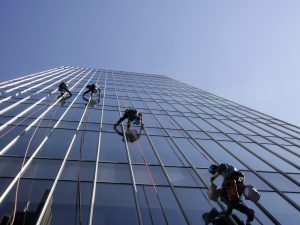The scaffolding standards of care can be ambiguous if not at times downright bizarre. Between the requirements of safety standards, the demands of the market place, and the confusion of inconsistent safety enforcement, it’s a wonder that there is any agreement within the industry. It’s amazing to me, however, how many myths are perpetuated in spite of the facts and reality.
As an example, take the former plank testing procedure that was affectionately called the “gorilla test.” For years this test was used as a legitimate method for judging the safety and suitability of solid sawn scaffold plank. The Scaffold Industry Association (SIA) even published the test parameters in the directory. Too bad the test is unscientific and invalid; it has been for a number of years. There are better methods for determining the strength, safety, and extent of possible damage of solid sawn scaffold grade plank than the gorilla test. But the gorilla won’t go away. Some plank users still use the test in spite of warnings not to.
Here’s another myth that seems to show up at the most inopportune time: The maximum permissible screw extension in a supported scaffold is 12 inches. While it is good construction practice to use as little screw extension as possible, the strength of the scaffold is not compromised with extensions exceeding 12 inches, provided you do not exceed the manufacturer’s recommendations. Where does the 12-inch myth come from? It’s not in the OSHA Construction or General Industry Standards. Is it in manufacturers’ data? I don’t believe so. How about the SIA? The code of safe practices does limit the screw extension on rolling scaffolds to 12 inches but this does not apply to stationary scaffolds. So why does this myth continue to reappear? I haven’t a clue.
What’s the deal with the fixed ladder standards and scaffolds? Why are so many people fascinated with trying to apply the fixed ladder standards to scaffolds? If you ever read the fixed ladder standards you’ll quickly realize that there is no way fixed ladder standards apply to scaffolds. Yes, the ladder is vertical; yes, the ladder has characteristics that make it look like a fixed ladder; yes, the ladder is clamped to the scaffold leg, but that is where the similarities end. A clamp on ladder doesn’t even fit in the definition of a fixed ladder. (If you don’t believe me, look it up in Subpart X of the OSHA Construction Standards.) It’s very clear that the scaffold standards address ladders clamped to scaffolds. And yet, people perpetuate the myth by trying to apply the fixed ladder standards to scaffolds in interesting but incorrect ways.
What about scaffolding and shoring? People constantly insist that a shoring deck is a scaffold. True, workers are standing on the deck installing rebar and placing concrete, but by definition, the shoring deck is a “walking/working surface,” not a scaffold work deck. And yet, people insist on applying the scaffold standards, especially if scaffold frames are used to hold the shoring deck.
Here’s another myth: Workers on all suspended scaffolds shall wear personal fall protection equipment. Not true! Workers on all single point and double point suspended scaffolds shall wear personal fall arrest equipment because failure of one line causes disastrous results. However, on multi-point scaffolds, (suspended scaffolds with multiple suspension lines,) personal fall arrest equipment is not required if a guardrail system is provided. No mystery; some people just don’t want to understand the hazards and the solutions.
The myth of toeboards fascinates me. Toeboards are one form of falling object protection. If there is nobody working below there is no hazard of a worker getting hit by falling objects. Unfortunately, there is a myth that toeboards are required on all scaffold decks, no matter if there is a falling object hazard or not. This is not true. Only when workers are working above each other, or there are employees walking under workers, is falling object protection required. Toeboards are one form of falling object protection that can be used. The next time there is no falling object hazard, and somebody tells you toeboards are required, ask them to show you where it says that in the standards.
Finally, what’s this thing with minimum design loads. The myth requires that all scaffolds shall be designed for at least a light duty load, 25 pounds per square foot. That’s not true. To compound the problem, there are those who think that a ten foot leg spacing automatically provides a light duty loading. The myth says that if the plank spans ten feet, then we can place 25 pounds per square foot on it. Not true. The truth is that scaffolds shall be designed to support four times the load that will be supported. The span and permissible loading of the deck or plank is determined by the strength of the plank, not by an arbitrary leg spacing or common cross brace size. Use the wrong type of plank on a ten foot span and you may seriously overload the plank by placing 25 pounds per square foot on it.
The fact is, and the truth is, there are baseless demands placed on scaffold erectors and users. If something doesn’t sound right, based on your knowledge of the standards, experience, and good construction practice, question it. You may learn something. On the other hand, the myth spinner may learn that scaffolding indeed is not mythological!












